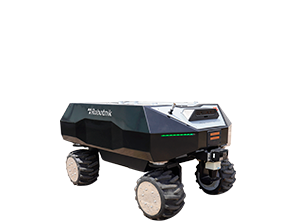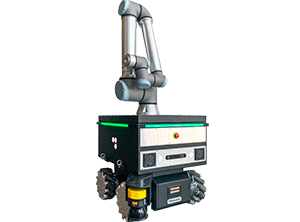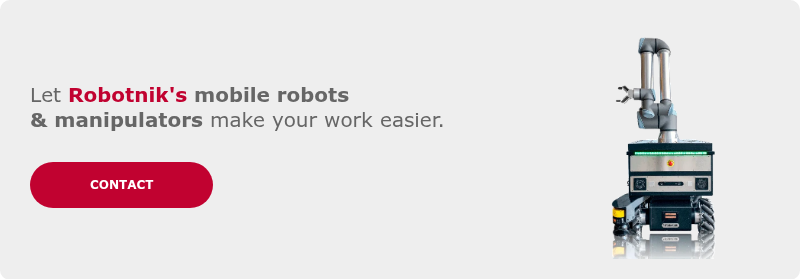Industrial automation increasingly demands systems that are integrated, secure, and standardized. To address this need and advance toward more reliable, scalable, and standardized robotics, Robotnik has incorporated Siemens’ SIMOVE platform into its portfolio of Autonomous Mobile Robots (AMRs).
This integration aims to expand access to industrial applications and enhance reliability in complex production environments.

A NEW GENERATION OF INDUSTRIAL MOBILE ROBOTS
SIMOVE is a modular automation platform developed by Siemens for controlling Automated Guided Vehicles (AGVs) and Autonomous Mobile Robots (AMRs) in industrial settings.
In essence, SIMOVE provides a standardized hardware and software architecture based on Siemens Programmable Logic Controllers (PLCs) and certified industrial components. This framework enables the control, monitoring, and management of mobile robot fleets across production plants, warehouses, and logistics centers.
Thanks to this architecture, Robotnik’s robots achieve higher levels of reliability, traceability, and regulatory compliance, meeting the demands of sectors such as automotive, pharmaceutical, and manufacturing industries that require certified, robust control systems.
EXPANDING BEYOND THE ROS ENVIRONMENT
Robotnik has built much of its development on ROS (Robot Operating System), a framework that promotes innovation, research, and flexibility in robotics. However, certain industrial environments require certified systems equipped with PLC-based control, standardized industrial communication, and long-term support.
The integration of Siemens’ SIMOVE platform enables Robotnik to address these challenges with a certified technological foundation that is fully compatible with industrial standards. SIMOVE provides a robust control layer based on Siemens hardware and software that complements the flexibility of ROS with enhanced reliability, predictability, and functional safety.
This is particularly relevant for mobile robots such as Robotnik’s RB-ROBOUT, a modular platform designed for industrial applications, featuring a payload capacity of up to 2 tons, ideal for transporting heavy loads in indoor industrial environments such as factories and warehouses.
STANDARDIZED, SAFE AND SCALABLE ROBOTICS
Adopting the SIMOVE platform provides Robotnik with a consolidated technological foundation for developing industrial mobile robotics with an open and modular architecture.
This collaboration results in several advantages that contribute to a more robust automation framework:
-
- Enhanced reliability and safety, through the use of Siemens industrial PLCs and secure communication protocols such as PROFINET and PROFIsafe.
- Compliance with industry standards, facilitating deployment in highly regulated industrial facilities.
- Simplified and faster integration, as SIMOVE-based AGVs can interface seamlessly with existing automation systems, reducing commissioning times.
The use of SIMATIC S7-1500 PLCs, SINAMICS Micro-Drives, and SCALANCE industrial network components ensures deterministic and safe control, reliable communication, and predictable behavior in critical environments.
Taken together, these features not only improve the operational reliability and performance of the robots but also simplify their integration into established automation ecosystems, enabling manufacturers and operators to maximize productivity without compromising the flexibility and modularity that define Robotnik’s robotics solutions.

TECHNOLOGICAL COLLABORATION AND SPECIALIZED SUPPORT
The collaboration between Robotnik’s and Siemens’ engineering teams has been instrumental in integrating the SIMOVE platform within the RB-ROBOUT product line. This partnership has combined Robotnik’s expertise in autonomous mobility, perception, and navigation with Siemens’ industrial control infrastructure and technological reliability.
The joint work has encompassed the configuration of the control architecture, functional validation of the various components, including SIMATIC S7-1500 PLCs, SINAMICS Micro-Drives, and SCALANCE industrial networks, as well as adaptation to the safety and communication standards required in industrial environments.
Siemens’ technical support has helped to shorten development cycles, ensure compatibility with existing infrastructures, and secure stable deployment in continuous-operation production settings.
Moreover, this collaboration lays a solid foundation for future system evolutions, including improved interoperability, enhanced functional safety features, and deeper integration with Industry 4.0 ecosystems, while maintaining the reliability and standardization expected in industrial applications.
Preguntas frecuentes sobre sobre róbotica en la industria aeroespacial
La robótica móvil permite automatizar tareas complejas como la manipulación de piezas de gran tamaño, el transporte de herramientas o la inspección de componentes. Gracias a su precisión, autonomía y capacidad de colaboración con operarios, mejora la productividad, la calidad del montaje y la seguridad laboral, reduciendo los tiempos de ciclo y los riesgos ergonómicos.
El RB-ROBOUT+ combina movilidad omnidireccional, manipulación de alta carga y sistemas avanzados de navegación y seguridad. Esta integración permite realizar operaciones de ensamblaje, inspección o manipulación con una precisión excepcional, adaptándose a distintos procesos y modelos de aeronaves. Además, su arquitectura abierta basada en ROS 2 facilita la integración con otros sistemas industriales.
Según organismos como la Royal Aeronautical Society o la International Federation of Robotics (IFR), la fabricación aeroespacial avanzará hacia entornos más automatizados, conectados e inteligentes. Tecnologías como la inteligencia artificial, la visión artificial y la robótica colaborativa seguirán impulsando fábricas más flexibles, sostenibles y orientadas a la trazabilidad total.


